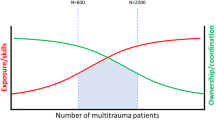Abstract
Introduction
The development of trauma systems all over the world resulted in improved outcome for a broad range of trauma victims. In this review, we demonstrate the developments of an inclusive regionalised trauma system in the Netherlands and the subsequent developments in our level one trauma centre and trauma region in comparison.
Comparison with other trauma systems
With the seasoning of the trauma system, further improvements in outcome could be demonstrated, in the region an OR of 0.84 and in the trauma centre an OR of 0.61, in a later comparison over the years another OR 0.74 was noted. In addition, a further diversification of the trauma populations was seen in the various hospitals with different levels, based on a pre-hospital triage system. Torso and multiple injured patients were more seen in the trauma centre and increased to more than 350 patients with an ISS of >15, whereas monotrauma was almost exclusively seen in the level two and three hospitals. The further development of the trauma system is discussed, in which the minimum requirements of the individual trauma surgeon and institution are taken as a guideline.
Future, discussion and conclusion
Based on these considerations, a further concentration of the most severely injured patients is proposed in a small country as the Netherlands culminating in one trauma centre for the most severely injured patients, combined with an integrated pre-hospital helicopter system, on top of the current good functioning inclusive trauma system. These developments could be a template for further developments of trauma systems in Europe.

Similar content being viewed by others
References
Scientific Council for Traffic Safety (SWOV). Public health and road safety. In Dutch: Volksgezondheid en verkeersveiligheid. http://www.swov.nl/rapport/r-2005-16.pdf.
ten Duis HJ, van der Werken C. Trauma care systems in The Netherlands. Injury. 2003;34(9):722–7.
Haarman H, van der Linden JTh, Manifesto Dutch Society for Traumatology. The organization of the extra-hospital care and patient about the accident in the Netherlands. In Dutch: Manifest Nederlandse Vereniging voor Traumatologie. De organisatie van de extra- en intramurale zorg omtrent de ongevalpatiënt in Nederland. 1987.
Lansink KWW, Leenen LPH. Do designated trauma systems improve outcome? Curr Opin Crit Care. 2007;13(6):686–90.
Advanced Trauma Life Support. http://www.atls.nl. 2009. Accessed 31 Jan 2011.
Ministry of Health, Welfare and Sport. With care connected. 1997. In Dutch: Ministerie van VWS en BZK. Met zorg verbonden. 1997.
Dutch Trauma Society. Trauma care: our care! 2009. In Dutch: Nederlandse Vereniging voor Traumatologie. Traumazorg: onze zorg! 2009.
Celso B, Tepas J, Langland-Orban B, Pracht E, Papa L, Lottenberg L, Flint L. A systematic review and meta-analysis comparing outcome of severely injured patients treated in trauma centers following the establishment of trauma systems. J Trauma. 2006;60(2):371–8.
Twijnstra MJ, Moons KGM, Simmermacher RKJ, Leenen LPH. Regional trauma system reduces mortality and changes admission rates: a before and after study. Ann Surg. 2010;251(2):339–43.
Spijkers ATE, Meylaerts SAG, Leenen LPH. Mortality decreases by implementing a level I trauma center in a Dutch hospital. J Trauma. 2010;69(5):1138–42.
Lansink K, Gunning AC, Leenen LPH. Evaluation of trauma care in a mature Level I trauma center in the Netherlands. ESTES Congress 2011, Abstract ID 1462.
Committee on Trauma, American College of Surgeons. Resources for optimal care of the injured patient: 2006. Chicago: American College of Surgeons.
Flohé S, Nast-Kolb D. Surgical management of life-threatening injuries. Unfallchirurg. 2009;112(10):854–9.
Scientific Council for Traffic Safety (SWOV). Predicting the number of traffic fatalities in 2020. In Dutch: Prognose van het aantal verkeersslachtoffers in 2020. http://www.swov.nl/rapport/R-2011-12-korte-versie.pdf.
Harborview Medical Center, Seattle, USA, yearly report. http://uwmedicine.washington.edu/Patient-Care/Locations/HMC/Clinical-Services/Specialty-Areas/trauma/Documents/HARB_TraumaRpt_2010_FINAL%20(2).pdf.
Dutton RP, Stansbury LG, Leone S, Kramer E, Hess JR, Scalea TM. Trauma mortality in mature trauma systems: are we doing better? An analysis of trauma mortality patterns, 1997–2008. J Trauma. 2010;69(3):620–6.
Sturms LM, Hoogeveen JM, Le Cessie S, Schenck PE, Pahlplatz PV, Hogervorst M, Jukema GN. Prehospital triage and survival of major trauma patients in a Dutch regional trauma system: relevance of trauma registry. Langenbecks Arch Surg. 2006;391(4):343–9.
Vles WJ, Kroezen F, Meeuwis JD, Leenen LPH. Trauma registration in a Dutch trauma population with emphasis on quality of care. Eur J Trauma. 2000;26:248–55.
Groven S, Eken T, Skaga NO, Roise O, Naess PA, Gaarder C. Long-lasting performance improvement after formalization of a dedicated trauma service. J Trauma. 2011;70:569–74.
Davenport RA, Tai N, West A, Bouamra O, Aylwin C, Woodford M, McGinley A, Lecky F, Walsh MS, Brohi K. A major trauma centre is a specialty hospital not a hospital of specialties. Br J Surg. 2010;97:109–17.
Ruchholtz S. The Trauma Registry of the German Society of Trauma Surgery as a basis for interclinical quality management. A multicenter study of the German Society of Trauma Surgery. Unfallchirurg. 2000;103(1):30–7.
Mommsen P, Bradt N, Zeckey C, Andruszkow H, Petri M, Frink M, Hildebrand F, Krettek C, Probst C. Comparison of helicopter and ground emergency medical service: a retrospective analysis of a German rescue helicopter base. Technol Health Care. 2012;20:49–56.
Conflict of interest
None.
Author information
Authors and Affiliations
Corresponding author
Rights and permissions
About this article
Cite this article
Lansink, K.W.W., Leenen, L.P.H. History, development and future of trauma care for multiple injured patients in the Netherlands. Eur J Trauma Emerg Surg 39, 3–7 (2013). https://doi.org/10.1007/s00068-012-0223-9
Received:
Accepted:
Published:
Issue Date:
DOI: https://doi.org/10.1007/s00068-012-0223-9




